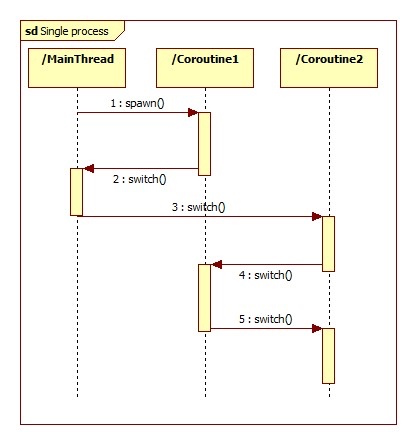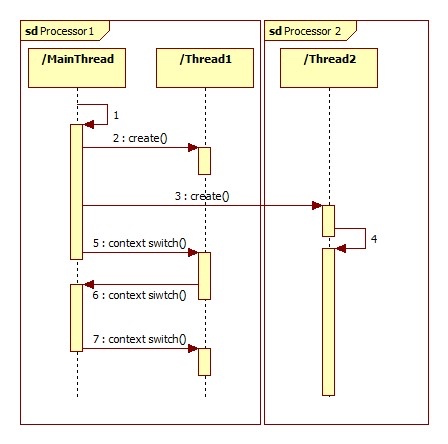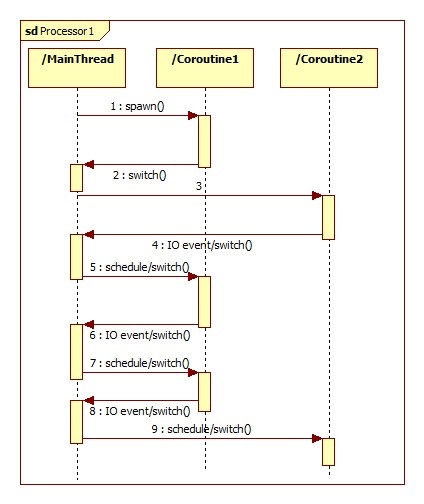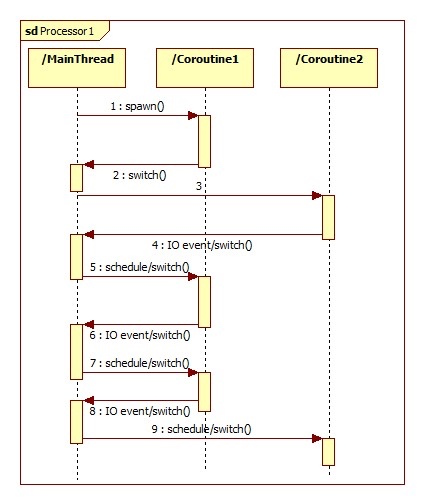基本概念
我们通常所说的协程Coroutine其实是corporate routine的缩写,直接翻译为协同的例程,一般我们都简称为协程。
在linux系统中,线程就是轻量级的进程,而我们通常也把协程称为轻量级的线程即微线程。
进程和协程
下面对比一下进程和协程的相同点和不同点:
相同点:
我们都可以把他们看做是一种执行流,执行流可以挂起,并且后面可以在你挂起的地方恢复执行,这实际上都可以看做是continuation,关于这个我们可以通过在linux上运行一个hello程序来理解:

shell进程和hello进程:
- 开始,shell进程在运行,等待命令行的输入
- 执行hello程序,shell通过系统调用来执行我们的请求,这个时候系统调用会讲控制权传递给操作系统。操作系统保存shell进程的上下文,创建一个hello进程以及其上下文并将控制权给新的hello进程。
- hello进程终止后,操作系统恢复shell进程的上下文,并将控制权传回给shell进程
- shell进程继续等待下个命令的输入
当我们挂起一个执行流的时,我们要保存的东西:
- 栈, 其实在你切换前你的局部变量,以及要函数的调用都需要保存,否则都无法恢复
- 寄存器状态,这个其实用于当你的执行流恢复后要做什么
而寄存器和栈的结合就可以理解为上下文,上下文切换的理解:
CPU看上去像是在并发的执行多个进程,这是通过处理器在进程之间切换来实现的,操作系统实现这种交错执行的机制称为上下文切换
操作系统保持跟踪进程运行所需的所有状态信息。这种状态,就是上下文。
在任何一个时刻,操作系统都只能执行一个进程代码,当操作系统决定把控制权从当前进程转移到某个新进程时,就会进行上下文切换,即保存当前进程的上下文,恢复新进程的上下文,然后将控制权传递到新进程,新进程就会从它上次停止的地方开始。
不同点:
- 执行流的调度者不同,进程是内核调度,而协程是在用户态调度,也就是说进程的上下文是在内核态保存恢复的,而协程是在用户态保存恢复的,很显然用户态的代价更低
- 进程会被强占,而协程不会,也就是说协程如果不主动让出CPU,那么其他的协程,就没有执行的机会。
- 对内存的占用不同,实际上协程可以只需要4K的栈就足够了,而进程占用的内存要大的多
- 从操作系统的角度讲,多协程的程序是单进程,单协程
线程和协程
既然我们上面也说了,协程也被称为微线程,下面对比一下协程和线程:
- 线程之间需要上下文切换成本相对协程来说是比较高的,尤其在开启线程较多时,但协程的切换成本非常低。
- 同样的线程的切换更多的是靠操作系统来控制,而协程的执行由我们自己控制
我们通过下面的图更容易理解:


从上图可以看出,协程只是在单一的线程里不同的协程之间切换,其实和线程很像,线程是在一个进程下,不同的线程之间做切换,这也可能是协程称为微线程的原因吧
继续分析协程:

Gevent
Gevent是一种基于协程的Python网络库,它用到Greenlet提供的,封装了libevent事件循环的高层同步API。它让开发者在不改变编程习惯的同时,用同步的方式写异步I/O的代码。
使用Gevent的性能确实要比用传统的线程高,甚至高很多。但这里不得不说它的一个坑:
- Monkey-patching,我们都叫猴子补丁,因为如果使用了这个补丁,Gevent直接修改标准库里面大部分的阻塞式系统调用,包括socket、ssl、threading和 select等模块,而变为协作式运行。但是我们无法保证你在复杂的生产环境中有哪些地方使用这些标准库会由于打了补丁而出现奇怪的问题
- 第三方库支持。得确保项目中用到其他用到的网络库也必须使用纯Python或者明确说明支持Gevent
既然Gevent用的是Greenlet,我们通过下图来理解greenlet:

每个协程都有一个parent,最顶层的协程就是man thread或者是当前的线程,每个协程遇到IO的时候就把控制权交给最顶层的协程,它会看那个协程的IO event已经完成,就将控制权给它。
下面是greenlet一个例子
# coding:utf-8
# !/user/bin/python
from greenlet import greenlet
def test1(x, y):
z = gr2.switch(x + y)
print "test1:" + str(z)
def test2(u):
print "test2:" + str(u)
gr1.switch(42)
gr1 = greenlet(test1)
gr2 = greenlet(test2)
gr1.switch("hello", 'world')
输出:
test2:helloworld
test1:42
===
greenlet(run=None, parent=None): 创建一个greenlet实例.
gr.parent:每一个协程都有一个父协程,当前协程结束后会回到父协程中执行,该 属性默认是创建该协程的协程.
gr.run: 该属性是协程实际运行的代码. run方法结束了,那么该协程也就结束了.
gr.switch(*args, **kwargs): 切换到gr协程.
gr.throw(): 切换到gr协程,接着抛出一个异常.
下面是gevent的一个例子:
# coding:utf-8
# !/user/bin/python
import gevent
def func1():
print("start func1")
gevent.sleep(2)
print("end func1")
def func2():
print("start func2")
gevent.sleep(1)
print("end func2")
gevent.joinall(
[
gevent.spawn(func1),
gevent.spawn(func2)
]
)
输出:
start func1
start func2
end func2
end func1
关于gevent中队列的使用
gevent中也有自己的队列,但是有一个场景我用的过程中发现一个问题,就是如果我在协程中通过这个q来传递数据,如果对了是空的时候,从队列获取数据的那个协程就会被切换到另外一个协程中,这个协程用于往队列里put放入数据,问题就出在,gevent不认为这个放入数据为IO操作,并不会切换到上一个协程中,会把这个协程的任务完成后在切换到另外一个协程。我原本想要实现的效果是往对了放入数据后就会切换到get的那个协程。(或许我这里理解有问题)下面是测试代码:
例1:
# coding:utf-8
# !/user/bin/python
import gevent
from gevent.queue import Queue
def func():
for i in range(10):
print("int the func")
q.put("test")
def func2():
for i in range(10):
print("int the func2")
res = q.get()
print("--->", res)
q = Queue()
gevent.joinall(
[
gevent.spawn(func2),
gevent.spawn(func),
]
)
输出:
int the func2
int the func
int the func
int the func
int the func
int the func
int the func
int the func
int the func
int the func
int the func
('--->', 'test')
int the func2
('--->', 'test')
int the func2
('--->', 'test')
int the func2
('--->', 'test')
int the func2
('--->', 'test')
int the func2
('--->', 'test')
int the func2
('--->', 'test')
int the func2
('--->', 'test')
int the func2
('--->', 'test')
int the func2
('--->', 'test')
===
如果我在fun函数的q.put("test")后面添加gevent.sleep(0),就会是如下效果:
例2:
# coding:utf-8
# !/user/bin/python
import gevent
from gevent.queue import Queue
def func():
for i in range(10):
print("int the func")
q.put("test")
gevent.sleep(0) # 阻塞,切换线程
def func2():
for i in range(10):
print("int the func2")
res = q.get()
print("--->", res)
q = Queue()
gevent.joinall(
[
gevent.spawn(func2),
gevent.spawn(func),
]
)
输出:
int the func2
int the func
('--->', 'test')
int the func2
int the func
('--->', 'test')
int the func2
int the func
('--->', 'test')
int the func2
int the func
('--->', 'test')
int the func2
int the func
('--->', 'test')
int the func2
int the func
('--->', 'test')
int the func2
int the func
('--->', 'test')
int the func2
int the func
('--->', 'test')
int the func2
int the func
('--->', 'test')
int the func2
int the func
('--->', 'test')
===
备注:
查看gevent.sleep(0)
hub = get_hub()
loop = hub.loop
if seconds <= 0:
waiter = Waiter()
loop.run_callback(waiter.switch)
waiter.get()
else:
hub.wait(loop.timer(seconds, ref=ref))
和hub.wait
waiter = Waiter()
unique = object()
watcher.start(waiter.switch, unique)
try:
result = waiter.get()
if result is not unique:
raise InvalidSwitchError('Invalid switch into %s: %r (expected %r)' % (getcurrent(), result, unique))
finally:
watcher.stop()
都直接switch了微线程,所以才有上述结果,但如果使用time.sleep(0)呢如下述代码
例3:
# coding:utf-8
# !/user/bin/python
import gevent
import time
from gevent.queue import Queue
def func():
for i in range(10):
print("int the func")
q.put("test")
time.sleep(0)
def func2():
for i in range(10):
print("int the func2")
res = q.get()
print("--->", res)
q = Queue()
gevent.joinall(
[
gevent.spawn(func2),
gevent.spawn(func),
]
)
输出:
int the func2
int the func
int the func
int the func
int the func
int the func
int the func
int the func
int the func
int the func
int the func
('--->', 'test')
int the func2
('--->', 'test')
int the func2
('--->', 'test')
int the func2
('--->', 'test')
int the func2
('--->', 'test')
int the func2
('--->', 'test')
int the func2
('--->', 'test')
int the func2
('--->', 'test')
int the func2
('--->', 'test')
int the func2
('--->', 'test')
结果就和例1一样,并没有切换微线程,因为没有进行switch,需要手工进行switch。
关于Gevent的问题
就像我上面说的gevent和第三方库配合使用会有一些问题,可以总结为:
python协程的库可以直接monkey path
gevent目前为止还是有很多缺陷,并且不是官网标准库,而在python3中有一个官网正在做并且在3.6中已经稳定的库asyncio,这也是一个非常具有野心的库,非常建议学习,我也准备后面深入了解
猴子补丁
python协程的库直接monkey path
# coding:utf-8 # !/user/bin/python ''' Created on 2017年4月7日 @author: yizhiwu gunicorn 配置文件 ''' import os import json import multiprocessing import gevent.monkey gevent.monkey.patch_all() # gunicorn配置 bind = "127.0.0.1:5000" # 绑定服务 timeout = 600 # 超时 10分钟 worker_class = 'gevent' # 使用gevent模式,还可以使用sync 模式,默认的是sync模式 loglevel = 'info' # 日志级别,这个日志级别指的是错误日志的级别,而访问日志的级别无法设置 access_log_format = '%(t)s %(p)s %(h)s "%(r)s" %(s)s %(L)s %(b)s %(f)s" "%(a)s"' # 设置gunicorn访问日志格式,错误日志无法设置 accesslog = "/dev/null" # 访问日志文件的路径 errorlog = "./log/gunicorn_errorlog.log" # 错误日志文件的路径 pidfile = "./log/gunicorn.pid" # 启动的进程数 # workers = multiprocessing.cpu_count() * 2 + 1 # 进程数(子进程共享了父进程的文件句柄,多进程共用一个 fd 的情况下使用 logging 模块写少量日志是进程安全的) workers = 4 threads = 2 # 指定每个进程开启的线程数 backlog = 512 # 监听队列
执行时直接启动命令:
gunicorn -c gunconf.py Main:app
备注:
Main为启动文件,app为主程的app,例如flask的
# coding:utf-8 # !/user/bin/python from flask import Flask app = Flask(__name__)